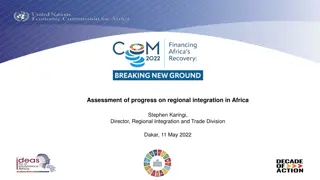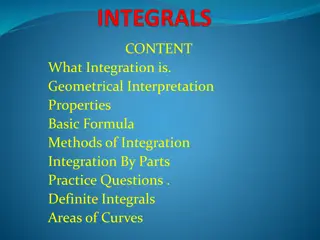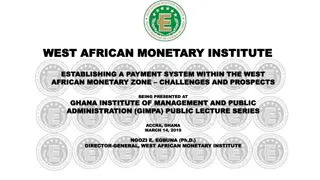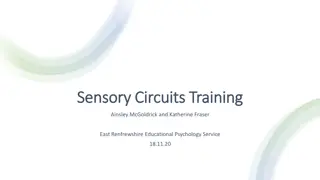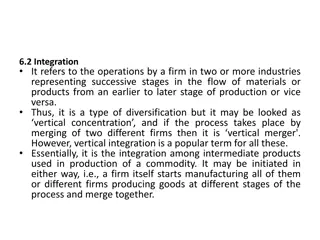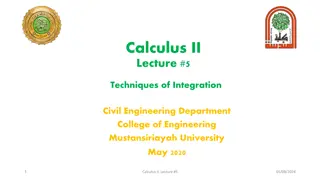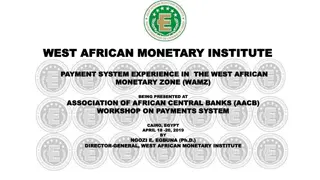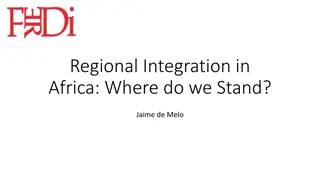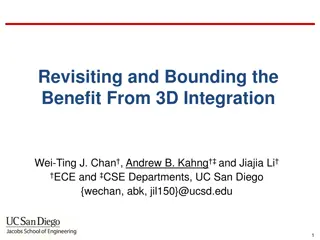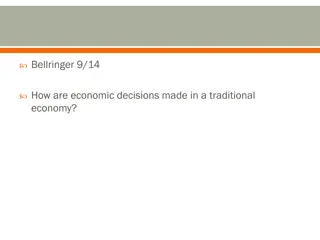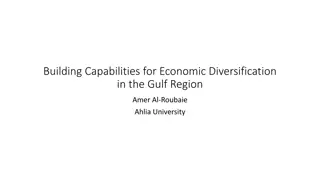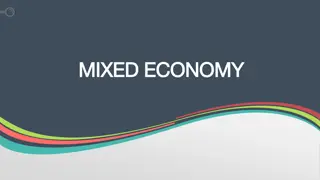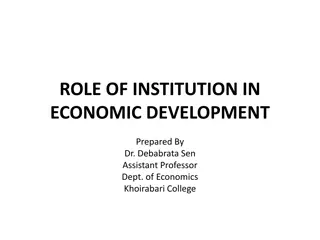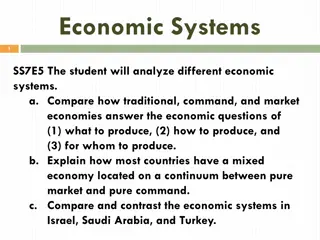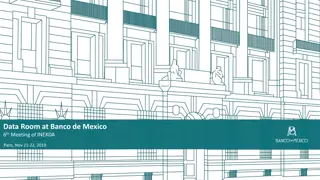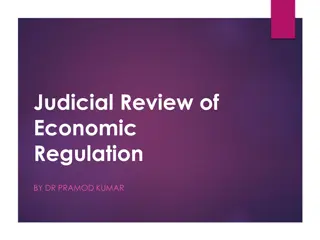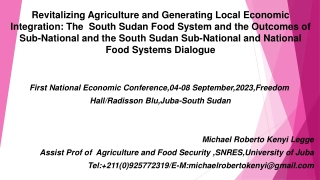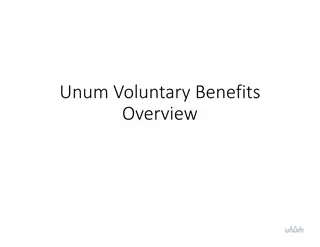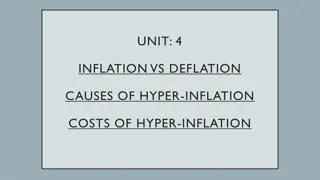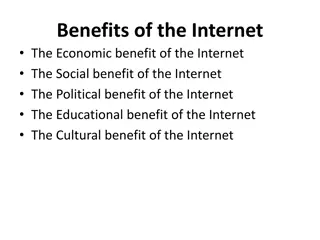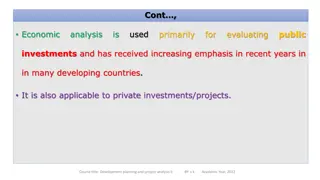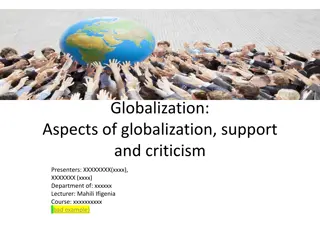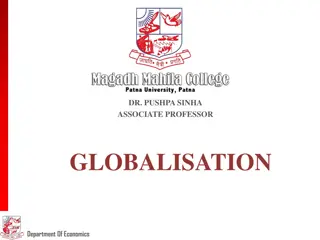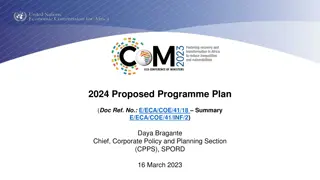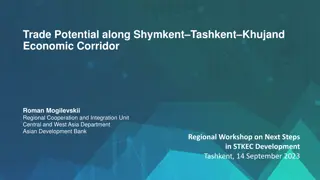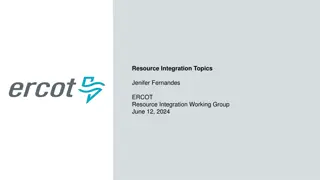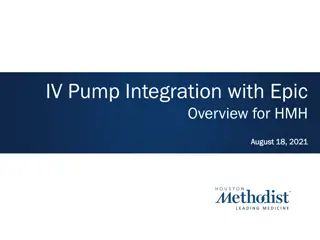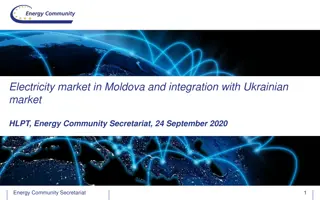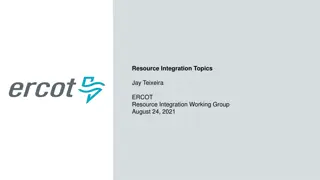Benefits of Economic Integration
Economic integration involves the unification of distinct economies into a larger economic region through the removal of trade barriers. It leads to economies of scale, international specialization, qualitative improvement in output, expansion of employment, and improvement in terms of trade. These benefits are made possible by re-introducing free trade among member nations and imposing a common external tariff policy against non-member countries.
Download Presentation

Please find below an Image/Link to download the presentation.
The content on the website is provided AS IS for your information and personal use only. It may not be sold, licensed, or shared on other websites without obtaining consent from the author. Download presentation by click this link. If you encounter any issues during the download, it is possible that the publisher has removed the file from their server.
E N D
Presentation Transcript
International Economic Integration The modern industrial system rests upon such techniques that can be employed economically only if the production takes place on a very large scale. This requires expanding markets on the one hand and increasing purchasing power with the people on the other. For the fullest exploitation of the production potential of the modern techniques, certain countries having small internal geographical markets, have attempted to organise themselves into regional groupings. The economic integration, in the
broadest sense, means the unification of distinct economies into a single larger economy. Thus the economic integration refers to an arrangement whereby two or more countries combine into a larger economic region through the removal of discontinuities and discriminations existing along following a common tariff and trade policies against the countries outside the group. national frontiers, while
There are two essential features of economic integration: (i) Re-introduction of free trade among the member nations. (ii) Imposition of a common external tariff policy against the non-member countries. From these two features, it follows that economic integration is a synthesis between free trade and tariff protection. Benefits of Economic Integration: (i) Economies of Scale: The individual countries, having small internal market, have limited capacity to expand production.
The economic integration provides an unrestricted access of the products produced by any member country. This gives strong inducement to expand production and exploit fully the economies of scale. (ii) International Specialisation: The economic integration enables the member countries to attain a greater degree of specialisation in both products and processes. Specialisation based on comparative cost advantage by a specific geographical region can cause considerably large expansion in production.
(iii) Qualitative Improvement in Output: The regional economic co-operation among a number of countries leads to rapid technological changes and larger and easier capital movements. The member countries, in such favourable conditions, can bring about qualitative improvement in production. (iv) Expansion of Employment: As some countries organise themselves into regional economic groups and allow unrestricted flow of labour within the region, there can be maximisation of employment and income.
(v) Improvement in Terms of Trade: The economic integration greatly increases the bargaining power of the member countries vis-a-vis the rest of the world. That brings about a significant improvement in their terms of trade. (vi) Increase in Economic Efficiency: The economic integration results in increased competition within the region. That helps in maintaining a higher level of economic efficiency of the group as a whole.
(vii) Improvement in Living Standard: As some countries organise themselves into regional groups, there is easier availability of superior varieties of goods at competitive prices. The increase in employment opportunities and the purchasing power too contributes in improving the living standards of the people. (viii) Increase in Factor Mobility: The economic integration leads to dismantling of barriers upon the movement of labour and other factors among the member countries. Increased factor mobility enlarges employment; lowers factor costs; and promotes productive activity in all the member countries.
Multilateralism It is a process of organizing relations between groups of three or more states. Beyond that basic quantitative aspect, multilateralism is generally considered to comprise certain qualitative elements or principles that shape the character of the arrangement or institution. Those principles are an indivisibility of interests among participants, a commitment to diffuse reciprocity and a system of dispute settlement intended to enforce a particular mode of behaviour. International organizations, such as the United Nations (UN) and the World Trade Organization, are multilateral in nature.
Regionalism, It is a phenomenon in international trade where states create groups for the purposes of trade and to collectively reduce barriers of trade among the members of a group. Most of this phenomenon appears in the form of Regional Trade Agreements (RTA). These groups, like all trade regimes, vary greatly in terms of the scope of the goods that are covered, the institutional bylaws and guidelines of these agreements, etc.
A region is often defined as a group of countries located in the same geographically specified area. example the African, Caribbean and Pacific Group of States which includes African, Caribbean, and Latin American nations. Trading Blocs A regional trading bloc is a group of countries within a geographical region that protect themselves from imports from non-members. Trading blocs are a form of economic integration and increasingly shape the pattern of world trade. There are several types of trading bloc:
On the basis of the degree of cooperation, the economic integration can be of the following main forms: (i) Preferential Trade Area or Association: The preferential trade area or association is the most-loose form of economic integration. In this arrangement, the member countries lower tariffs on imports from each other. It means they offer preferential treatment to the member countries. (ii) Free Trade Area: In this form of economic integration, the member countries
abolish completely both tariff and quantitative trade restrictions among themselves. However, each member country is free to maintain its own trade barriers against the non- member countries. An important example of free trade area is the European Free Trade Association (EFTA). Example Latin American Free Trade Association (LAFTA). It was formed in June 1961 by 10 Latin American countries. (iii) Customs Union: A more formal type of integration among two or more countries is the customs union. In this form of integration, the member countries abolish all tariffs and other barriers on trade among themselves.
As regards the rest of the world, they adopt a common external tariff and commercial policy. The customs unions and free trade area are similar in respect of abolition of all trade barriers for the member countries. But the customs union is distinct from the free trade area in respect of the common external tariff against the non- member countries. In case of free trade area, the member countries retain their own tariff and other trade barriers against the non-member countries. Thus customs union is a more closely- knit form of integration than the free trade area. In a customs union,
all the member countries act as a single economic unit against the non-member countries. (iv) Common Market: The common market signifies a more unified arrangement among a group of countries than the customs union. The common market involves the abolition of tariff and trade restrictions among the member countries and adoption of a common external tariff. It goes even beyond that and allows free movement of labour and capital among the member nations.
Thus in case of a common market, there is a free and integrated movement of goods and factors among the member countries. The European Common Market (ECM) called also as the European Economic Community (EEC) is the best example of the common market. (v) Economic Union: The most advanced form of economic integration involving the greatest degree of co-operation is the economic union. In case of an economic union, two or more countries form a common market. In addition, they proceed to harmonise and unify their fiscal, monetary, exchange rate, industrial and
other socio-economic policies. The member countries attempt to have a common currency and banking system. An interesting recent development, based on the principles of integration, has been the duty-free zones or economic zones. Such areas have been set up in different countries or regions with the object of attracting foreign investment through duty- free imports of raw materials and intermediate products. (vi) Monetary Union Monetary union involves scrapping individual currencies, and adopting a single, shared currency, such as the Euro for the
Euro-17 countries, and the East Caribbean Dollar for 11 islands in the East Caribbean. This common exchange rate, a common monetary policy including interest rates and the regulation of the quantity of money and a single central bank, such as the European Central Bank or the East Caribbean Central Bank. (vii) Fiscal Union A fiscal union is an agreement to harmonise tax rates, to establish common levels of public sector spending and borrowing, and jointly agree national budget deficits or surpluses. The majority of EU states agreed a fiscal compact in early 2012. means that there is a
(viii) Economic and Monetary Union Economic and Monetary Union (EMU) is a key stage towards compete integration, and involves a single economic market, a common trade policy, a single currency and a common monetary policy. (ix) Complete Economic Integration Complete economic integration involves a single economic market, a common trade policy, a single currency, a common monetary policy, together with a single fiscal policy, including common tax and benefit rates in short, complete harmonisation of all policies, rates, and economic trade rules.
Objectives of economic integration 1. Economic growth through larger markets 2. Decrease regional inequality 3. Strengthen bargaining power 4. Develop cooperative solutions
Disadvantages of Economic Integration 1.Creation Of Trading Blocs: It can also increase trade barriers against non-member countries. 2. Trade Diversion: Because of trade barriers, trade is diverted from a non-member country to a member country despite the inefficiency in cost. For example, a country has to stop trading with a low cost manufacture in a non-member country and trade with a manufacturer in a member country which has a higher cost.
3. National Sovereignty: Requires member countries to give up some degree of control over key policies like trade, monetary and fiscal policies. The higher the level of integration, the greater the degree of controls that needs to be given up particularly in the case of a political union economic integration which requires nations to give up a high degree of sovereignty.
European Union and Brexit The European Union is a unified trade and monetary body of 28 member countries. It eliminates all border controls between members. That allows the free flow of goods and people, except for random spot checks for crime and drugs. The EU transmits state-of-the-art technologies to its members. The areas that protection, research and development, and energy. Public contracts are open to bidders from any member country. Any product manufactured in one country can be benefit are environmental
sold to any other member without tariffs or duties. Taxes are all standardized. Practitioners of most services, such as law, medicine, tourism, banking, and insurance, can operate in all member countries. As a result, the cost of airfares, the internet, and phone calls have fallen dramatically. Purpose Its purpose is to be more competitive in the global marketplace. At the same time, it must balance the needs of its independent fiscal and political members.
Countries under EU The EU's 28 member countries are: Austria, Belgium, Bulgaria, Croatia, Cyprus, Czech Republic, Denmark, Estonia, Finland, France, Germany, Greece, Hungary, Ireland, Italy, Latvia, Lithuania, Luxembourg, Malta, Netherlands, Poland, Portugal, Romania, Slovakia, Slovenia, Spain, Sweden, and the United Kingdom. That will drop to 27 after Brexit causes the United Kingdom to leave the EU in 2019. How It Is Governed Three bodies run the EU. The EU Council represents national governments. The Parliament is elected by the people.
The European Commission is the EU staff. They make sure all members act consistently in regional, agricultural, and social policies. Contributions of 120 billion euros a year from member states fund the EU. Here's how the three bodies uphold the laws governing the EU. These are spelled out in a series of treaties and supporting regulations: 1. The EU Council sets the policies and proposes new legislation. The political leadership, or Presidency of the EU, is held by a different leader every six months.
2. The European Parliament debates and approves the laws proposed by the Council. Its members are elected every five years. 3. The European Commission staffs and executes the laws. Jean-Claude Juncker is the president until October 2019. Currency The euro is the common currency for the EU area. It is the second most commonly held currency in the world, after the U.S. dollar. It replaced the Italian lira, the French franc, and the German deutschmark, among others.
The value of the euro is free-floating instead of a fixed exchange rate. As a result, foreign exchange traders determine its value each day. The most widely-watched value is how much the euro's value is compared to the U.S. dollar. The dollar is the unofficial world currency. History In 1950, the concept of a European trade area was first established. The European Coal and Steel Community had six founding members: Belgium, France, Germany, Italy, Luxembourg, and the Netherlands. In 1957, the Treaty of Rome established a common market. It eliminated customs
duties in 1968. It put in place standard policies, particularly in trade and agriculture. In 1973, the ECSC added Denmark, Ireland, and the United Kingdom. It created its first Parliament in 1979. Greece joined in 1981, followed by Spain and Portugal in 1986. In 1993, the Treaty of Maastricht established the European Union common market. Two years later, the EU added Austria, Sweden, and Finland. In 2004, twelve more countries joined: Bulgaria, Cyprus, Czech Republic, Estonia, Hungary, Latvia, Lithuania, Malta, Poland, Romania, Slovakia, and Slovenia.
In 2009, the Treaty of Lisbon increased the powers of the European Parliament.5It gave the EU the legal authority to negotiate and sign international treaties. It increased EU powers, border control, immigration, judicial cooperation in civil and criminal matters, and police cooperation. It abandoned the idea of a European Constitution. European law is still established by international treaties. The EU single market involves integration between nations and is built upon four key freedoms: 1. 1.Free Trade in Goods: Businesses can sell their products anywhere in the EU's member states and consumers can buy
where they want with no penalty. Intra-EU trade of goods represents 75% of intra-EU trade flows. For countries such as the Czech Republic and Hungary, trade with the EU accounts for over 90% of their trade showing how important is the single market to their economic fortunes. 2. Mobility of Labour: Citizens of EU member states can live, study and work in any other country. The aim is to improve the mobility of labour. Every year over 180 000 European students move to another Member State for the Erasmus programme or to attend a post graduate degree. But overall, Europe is an area of low mobility with only 2% of Europeans
living in a Member State different from that of their nationality. This figure is three times higher in the United States. An estimated 12m European citizen live in an EU country other than their own 3.Free Movement of Capital: Currencies and capital can flow freely between member states and EU citizens can use financial services in any member state 4.Free Trade in Services: Professional services such as pensions, architecture, telecoms and advertising can be offered in any member state. Services account for over 70 per cent of GDP in many EU countries. But progress in expanding
intra-EU trade in services has been slow. At present, only 20% of the services provided in the EU have a cross-border dimension Euro Zone Crisis The European sovereign debt crisis was a period when several European countries experienced the collapse of financial institutions, high government debt, and rapidly rising bond yield spreads in government securities. he debt crisis began in 2008 with the collapse of Iceland's banking system, then spread primarily to Portugal, Italy,
Ireland, Greece, and Spain in 2009. It has led to a loss of confidence in European businesses The crisis was eventually controlled by the financial guarantees of European countries, who feared the collapse of the euro and financial contagion, and by the International Monetary Fund (IMF). Rating agencies downgraded several Eurozone countries' debts. Greece's debt was, at one point, moved to junk status. Countries receiving bailout meet austerity measures designed to slow down the growth of public-sector debt as part of the loan agreements. and economies. funds were required to



